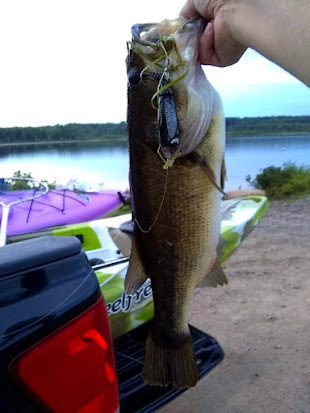As the days get shorter and the temperatures start to drop, bass fishing enters one of its best seasons - the early fall. The cooling water triggers feeding activity, and bass start bulking up for winter.
Use these early fall fishing tips to help you catch more and bigger bass during the summer to fall transition:
1. Target Wind Blown Banks
Fall winds pushes micro-organisms and therefore baitfish to wind-blown banks also drawing active bass to those areas as well. Position your boat (or you if fishing from the bank) upwind and work baits imitating local baitfish around available cover and structure to entice feeding bass into biting.
2. Fish Shallows Early and Late
Bass will still be active in shallow areas early and late when the water is warmer. Focus on shallow structure like stumps, docks, and grass edges, especially on sunny days. Topwaters, walking baits, and buzzbaits can be productive when bass are chasing baitfish in the shallows.
3. Fish the Backs of Creeks
Creeks often cool down faster than main lake areas. The baitfish and bass will move into the backs of creeks as the water temps drop. Target creek mouths, pockets, and anywhere creek channels swing close to shallow cover.
4. Follow the Bait
Cooling water temperatures trigger shad and other forage species to bunch up, making them easy targets for hungry bass. Look for balls of baitfish near structure on your electronics as well as signs of surface activity and keep moving to find the feeding bass. Match the hatch with shad or perch pattern crankbaits, blade baits, and swimbaits.
5. Fish Slow Tapering Points
Points that gradually slope out to deeper water form structure that congregates both baitfish and bass. Drag Carolina rigs, deep diving cranks, jigs, or dropshot rigs along these transitional areas. Focus on the shallow end of the point and out toward deeper water.
6. Fish Isolated Cover
Bass will often hold tight to cover like stumps, brush piles, rocks, and docks in the fall. Thoroughly work around isolated pieces of hard cover with jigs, Texas rigs, bladed jigs, and jerkbaits. Making repeated casts to high percentage areas like shady areas or along current seams are often key to triggering strikes from cover-relating bass.
7. Use Reaction Baits Around Baitfish Schools
When you spot a group of bass stacked up on structure and chasing baitfish, use reaction baits to trigger reflex strikes. Lipless cranks, jerkbaits, bladed jigs, and swim jigs can all quickly draw strikes when retrieved around baitfish schools before they keep migrating. Have a follow-up bait (jigs or weighted soft plastics) ready to pitch back to stubborn when short striking your first offering.
8. Keep Moving Until You Find Fish
Don't be afraid to pick up and move to a different spot when the bite dies off in an area. Bass are usually on the move in the fall and you need to keep moving to stay ahead of them. Eliminate unproductive water, and keep hitting new spots until you dial in an area holding active fish. Once bass are located, slow down and work the area thoroughly before moving to a new location.
9. Match Lure Selection to Weather Conditions
As fronts move through, cooling or warming water trends are common in the shallows, often causing bass locations and moods to change quickly. Reaction baits like crankbaits and spinnerbaits are better on warming trends, while jigs and soft plastics excel in cooling conditions. Pay attention to weather and make appropriate tackle adjustments.
10. Have Variety in Your Fall Tackle Arsenal
Because bass are in transition during early fall, having a wide variety of bait types and colors is essential. Make sure you have baits that cover all depths of the water column and structure/cover you may be fishing. When the bite is tough, switching to finesse-style baits and techniques is often the key to triggering more strikes.
As the weather cools during the early fall period, get out there and give these fall bass fishing tips a try. Adjust to the changing conditions, and you'll be reeling in the fall lunkers throughout this cooling water period.
















